Experimental Investigation of Single-Cylinder Engine Performance Using Biodiesel Made from Waste Swine Oil
Abstract
:1. Introduction
1.1. Background: Importance of Alternative Fuels
1.2. Objectives of the Current Study
- Investigate the properties of biodiesel derived from waste swine oil.
- Assess the performance characteristics of a single-cylinder engine when fueled with this biodiesel at a 75% load condition.
- Analyze the emissions profile and compare it to traditional biodiesel and diesel fuels under similar conditions.
- Provide insight and recommendations for the wider adoption of waste swine oil as a biodiesel feedstock.
2. Literature Review
2.1. Previous Studies on Biodiesel and Its Feedstocks
2.2. Impact of Engine Load on Performance and Emissions
3. Materials and Methods
3.1. Production of Biofuel and Its Blends
3.2. Engine Specifications and Setup
3.3. Test Procedures
3.4. Error Analysis and Uncertainty
4. Results and Discussion
4.1. Biodiesel Characterization
4.1.1. Fuel Properties
- B20: This blend contained 20% biofuel and 80% conventional diesel.
- B40: This blend consisted of 40% biofuel and 60% conventional diesel.
- B60: This blend included 60% biofuel and 40% conventional diesel.
- B80: This blend comprised 80% biofuel and 20% conventional diesel.
4.1.2. Comparison with Standard Diesel
4.2. Engine Performance at 75% Load
4.2.1. Brake-Specific Fuel Consumption (BSFC)
4.2.2. Brake Thermal Efficiency (BTE)
4.3. Emission Characteristics
4.3.1. Variation in Carbon Monoxide (CO) with Engine Speed
4.3.2. Variation in HC with Engine Speed
4.3.3. Variation of CO2 with Engine Speed
4.3.4. Variation in NOX with Engine Speed
4.3.5. Variation in Smoke Opacity with Engine Speed
4.4. Implications for Real-World Applications
4.5. Advantages and Challenges of Using Biodiesel from Waste Swine Oil
- Waste Utilization: Using waste swine oil for biodiesel production offers an excellent waste management solution [39].
- Reduced CO and HC Emissions: Lower carbon monoxide and hydrocarbon emissions make it environmentally advantageous in some aspects [40].
- Lower Smoke Emissions: The significant reduction in smoke opacity is both an environmental and public health benefit [41].
- Elevated NOx Emissions: The rise in NOx emissions is a critical drawback that could limit the use of biodiesel in certain applications [42].
- Increased BSFC: Higher fuel consumption for the same energy output makes it less efficient.
- CO2 Emissions: Contrary to the trends in other emissions, biodiesel produces higher CO2 levels, posing challenges for its overall environmental footprint [33].
5. Conclusions
- CO Emissions: Biodiesel blends showed reduced carbon monoxide emissions, which is an environmental benefit.
- HC Emissions: Hydrocarbon emissions were also generally lower for biodiesel blends at higher engine speeds.
- CO2 Emissions: An increase in CO2 emissions due to complete combustion of biodiesel in the engine was observed for biodiesel blends, calling attention to its environmental drawbacks.
- NOx Emissions: An increase in nitrogen oxides was noted for biodiesel, which aligns with the literature and is attributed to biodiesel’s higher combustion temperature.
- Smoke Opacity: Biodiesel blends resulted in significantly lower smoke emissions, offering both environmental and public health advantages.
Author Contributions
Funding
Data Availability Statement
Conflicts of Interest
Nomenclature
| PPM | Parts Per Million |
| RPM | Revolutions Per Minute |
| BP | Brake Power |
| KOH | Potassium Hydroxide |
| BSFC | Brake-Specific Fuel Consumption |
| BTE | Brake Thermal Efficiency |
| EGR | Exhaust Gas Recirculation |
| CO | Carbon Monoxide |
| CO2 | Carbon Dioxide |
| HC | Hydrocarbon |
| NOX | Nitrogen Oxide |
References
- Zheng, F.; Cho, H. Combustion and Emission of Castor Biofuel Blends in a Single-Cylinder Diesel Engine. Energies 2023, 16, 5427. [Google Scholar] [CrossRef]
- Knothe, G.; Razon, L.F. Biodiesel fuels. Prog. Energy Combust. Sci. 2017, 58, 36–59. [Google Scholar] [CrossRef]
- Ashok, B.; Nanthagopal, K. Eco friendly biofuels for CI engine applications. In Advances in Eco-Fuels for a Sustainable Environment; Woodhead Publishing: Sawston, UK, 2019; pp. 407–440. [Google Scholar]
- Eremeeva, A.M.; Ilyushin, Y.V. Automation of the control system for drying grain crops of the technological process for obtaining biodiesel fuels. Sci. Rep. 2023, 13, 14956. [Google Scholar] [CrossRef] [PubMed]
- Baldino, C.; Searle, S.; Zhou, Y. Alternative Uses and Substitutes for Wastes, Residues, and Byproducts Used in Fuel Production in the United States. Working Paper 2020-25. 2020. Available online: https://theicct.org/wp-content/uploads/2021/06/Alternative-wastes-biofuels-oct2020.pdf (accessed on 26 August 2023).
- Ravikumar, R.; Kiran, K.; Gurumoorthy, S.H. Experimental analysis of biofuel produced from fat derivatives of bird and animal as an additive fuel in CI engine. Int. J. Renew. Energy Res. 2020, 10, 1226–1233. [Google Scholar]
- Veljković, V.B.; Banković-Ilić, I.B.; Stamenković, O.S.; Hung, Y.T. Waste Vegetable oils, fats, and cooking oils in biodiesel production. Integr. Nat. Resour. Res. 2021, 22, 147–263. [Google Scholar]
- Mariadhas, A.; Kumar, B.S.; Kabilan, K.; Jayaraman, J.; Alagu, K.; Joy, N.; Nirmala, N. Technical insights of microalgae derived bio-diesel on its performance and emission characteristics, techno-economics and practicability huddles. Fuel 2023, 349, 128744. [Google Scholar] [CrossRef]
- An, H.; Yang, W.M.; Chou, S.K.; Chua, K.J. Combustion and emissions characteristics of diesel engine fueled by biodiesel at partial load conditions. Appl. Energy 2012, 99, 363–371. [Google Scholar] [CrossRef]
- Nguyen, T.; Pham, M.; Le Anh, T. Spray, combustion, performance and emission characteristics of a common rail diesel engine fueled by fish-oil biodiesel blends. Fuel 2020, 269, 117108. [Google Scholar] [CrossRef]
- Yana, S.; Nizar, M.; Mulyati, D. Biomass waste as a renewable energy in developing bio-based economies in Indonesia: A review. Renewable and Sustainable Energy Rev. 2022, 160, 112268. [Google Scholar] [CrossRef]
- Okolie, J.A.; Epelle, E.I.; Tabat, M.E.; Orivri, U.; Amenaghawon, A.N.; Okoye, P.U.; Gunes, B. Waste biomass valorization for the production of biofuels and value-added products: A comprehensive review of thermochemical, biological and integrated processes. Process Saf. Environ. Prot. 2022, 159, 323–344. [Google Scholar] [CrossRef]
- Zhang, C.; Hui, X.; Lin, Y.; Sung, C.J. Recent development in studies of alternative jet fuel combustion: Progress, challenges, and opportunities. Renew. Sustain. Energy Rev. 2016, 54, 120–138. [Google Scholar] [CrossRef]
- Imdadul, H.K.; Masjuki, H.H.; Kalam, M.A.; Zulkifli NW, M.; Rashed, M.M.; Rashedul, H.K.; Monirul, I.M.; Mosarof, M.H. A comprehensive review on the assessment of fuel additive effects on combustion behavior in CI engine fuelled with diesel biodiesel blends. RSC Adv. 2015, 5, 67541–67567. [Google Scholar] [CrossRef]
- Kamil, M.; Almarashda, F.M. Economic Viability and Engine Performance Evaluation of Biodiesel Derived from Desert Palm Date Seeds. Energies 2023, 16, 1513. [Google Scholar] [CrossRef]
- Suresh, T.; Sivarajasekar, N.; Balasubramani, K.J.R.E. Enhanced ultrasonic assisted biodiesel production from meat industry waste (pig tallow) using green copper oxide nanocatalyst: Comparison of response surface and neural network modelling. Renew. Energy 2021, 164, 897–907. [Google Scholar] [CrossRef]
- Bhatia, S.K.; Bhatia, R.K.; Jeon, J.M.; Pugazhendhi, A.; Awasthi, M.K.; Kumar, D.; Yang, Y.H. An overview on advancements in biobased transesterification methods for biodiesel production: Oil resources, extraction, biocatalysts, and process intensification technologies. Fuel 2021, 285, 119117. [Google Scholar] [CrossRef]
- Madhu, S.; Leo, G.L.; Prathap, P.; Devarajan, Y.; Jayabal, R. Effective utilization of waste pork fat as a potential alternate fuel in CRDI research diesel engine–Waste reduction and consumption technique. Process Saf. Environ. Prot. 2023, 172, 815–824. [Google Scholar] [CrossRef]
- Costa, J.; Martins, J.; Arantes, T.; Gonçalves, M.; Durão, L.; Brito, F. Experimental assessment of the performance and emissions of a spark-ignition engine using waste-derived biofuels as additives. Energies 2021, 14, 5209. [Google Scholar] [CrossRef]
- Orihuela, M.; Haralampous, O.; Chacartegui, R.; García, M.; Martinez-Fernandez, J. Numerical simulation of a wall-flow particulate filter made of biomorphic silicon carbide able to fit different fuel/biofuel inputs. Processes 2019, 7, 945. [Google Scholar] [CrossRef]
- Masera, K.; Hossain, A. Biofuels and thermal barrier: A review on compression ignition engine performance, combustion and exhaust gas emission. J. Energy Inst. 2019, 92, 783–801. [Google Scholar] [CrossRef]
- Li, X.; Wang, Y.; Duan, L.; Hao, J.; Nie, Y. Carbonaceous aerosol emissions from household biofuel combustion in china. Environ. Sci. Technol. 2009, 43, 6076–6081. [Google Scholar] [CrossRef]
- Feng, C.; Zhang, M.; Wu, H. Combustion of fuel mixtures containing crude glycerol (cg): Important role of interactions between cg and fuel components in particulate matter emission. Ind. Eng. Chem. Res. 2018, 57, 4132–4138. [Google Scholar] [CrossRef]
- Alajmi, F.S.; Hairuddin, A.A.; Adam, N.M.; Abdullah, L.C. Recent trends in biodiesel production from commonly used animal fats. Int. J. Energy Res. 2018, 42, 885–902. [Google Scholar] [CrossRef]
- Mandal, A.; Cha, D.; Cho, H. Impact of Waste Fry Biofuel on Diesel Engine Performance and Emissions. Energies 2023, 16, 3711. [Google Scholar] [CrossRef]
- Jariah, N.F.; Hassan, M.A.; Taufiq-Yap, Y.H.; Roslan, A.M. Technological advancement for efficiency enhancement of biodiesel and residual glycerol refining: A mini review. Processes 2021, 9, 1198. [Google Scholar] [CrossRef]
- Baweja, S.; Trehan, A.; Kumar, R. Combustion, performance, and emission analysis of a CI engine fueled with mustard oil biodiesel blended in diesel fuel. Fuel 2021, 292, 120346. [Google Scholar] [CrossRef]
- Reddy, S.R.; Murali, G.; Shaik, A.A.; Raju, V.D.; Reddy, M.S. Experimental evaluation of diesel engine powered with waste mango seed biodiesel at different injection timings and EGR rates. Fuel 2021, 285, 119047. [Google Scholar] [CrossRef]
- Elkelawy, M.; Bastawissi, H.A.E.; Esmaeil, K.K.; Radwan, A.M.; Panchal, H.; Sadasivuni, K.K.; Suresh, M.; Israr, M. Maximization of biodiesel production from sunflower and soybean oils and prediction of diesel engine performance and emission characteristics through response surface methodology. Fuel 2020, 266, 117072. [Google Scholar] [CrossRef]
- Devarajan, Y.; Munuswamy, D.B.; Nalla, B.T.; Choubey, G.; Mishra, R.; Vellaiyan, S. Experimental analysis of Sterculia foetida biodiesel and butanol blends as a renewable and eco-friendly fuel. Ind. Crops Prod. 2022, 178, 114612. [Google Scholar] [CrossRef]
- Labeckas, G.; Slavinskas, S.; Kanapkienė, I. The individual effects of cetane number, oxygen content or fuel properties on the ignition delay, combustion characteristics, and cyclic variation of a turbocharged CRDI diesel engine–Part 1. Energy Convers. Manag. 2017, 148, 1003–1027. [Google Scholar] [CrossRef]
- Sayin, C.; Gumus, M. Impact of compression ratio and injection parameters on the performance and emissions of a DI diesel engine fueled with biodiesel-blended diesel fuel. Appl. Therm. Eng. 2011, 31, 3182–3188. [Google Scholar] [CrossRef]
- Venu, H.; Madhavan, V. Influence of diethyl ether (DEE) addition in ethanol-biodiesel-diesel (EBD) and methanol-biodiesel-diesel (MBD) blends in a diesel engine. Fuel 2017, 189, 377–390. [Google Scholar] [CrossRef]
- Chiong, M.C.; Chong, C.T.; Ng, J.H.; Tran, M.V.; Lam, S.S.; Valera-Medina, A.; Jaafar, M.N.M. Combustion and emission performances of coconut, palm and soybean methyl esters under reacting spray flame conditions. J. Energy Inst. 2019, 92, 1034–1044. [Google Scholar] [CrossRef]
- Cheng, A.S.; Upatnieks, A.; Mueller, C.J. Investigation of the impact of biodiesel fuelling on NO x emissions using an optical direct injection diesel engine. Int. J. Engine Res. 2006, 7, 297–318. [Google Scholar] [CrossRef]
- Mueller, C.J.; Boehman, A.L.; Martin, G.C. An experimental investigation of the origin of increased NOx emissions when fueling a heavy-duty compression-ignition engine with soy biodiesel. SAE Int. J. Fuels Lubr. 2009, 2, 789–816. [Google Scholar] [CrossRef]
- Panithasan, M.S.; Gopalakichenin, D.; Venkadesan, G.; Veeraraagavan, S. Impact of rice husk nanoparticle on the performance and emission aspects of a diesel engine running on blends of pine oil-diesel. Environ. Sci. Pollut. Res. 2019, 26, 282–291. [Google Scholar] [CrossRef] [PubMed]
- Mohite, S.; Kumar, S.; Maji, S. Performance characteristics of mix oil biodiesel blends with smoke emissions. Int. J. Renew. Energy Dev. 2016, 5, 163–170. [Google Scholar] [CrossRef]
- Hafid, H.S.; Omar, F.N.; Abdul Rahman, N.A.; Wakisaka, M. Innovative conversion of food waste into biofuel in integrated waste management system. Crit. Rev. Environ. Sci. Technol. 2022, 52, 3453–3492. [Google Scholar] [CrossRef]
- Bhuiya, M.M.K.; Rasul, M.G.; Khan, M.M.K.; Ashwath, N.; Azad, A.K.; Hazrat, M.A. Prospects of 2nd generation biodiesel as a sustainable fuel–Part 2: Properties, performance and emission characteristics. Renew. Sustain. Energy Rev. 2016, 55, 1129–1146. [Google Scholar] [CrossRef]
- Mofijur, M.; Rasul, M.G.; Hyde, J.J.P.E. Recent developments on internal combustion engine performance and emissions fuelled with biodiesel-diesel-ethanol blends. Procedia Eng. 2015, 105, 658–664. [Google Scholar] [CrossRef]
- Gharehghani, A.; Pourrahmani, H. Performance evaluation of diesel engines (PEDE) for a diesel-biodiesel fueled CI engine using nano-particles additive. Energy Convers. Manag. 2019, 198, 111921. [Google Scholar] [CrossRef]

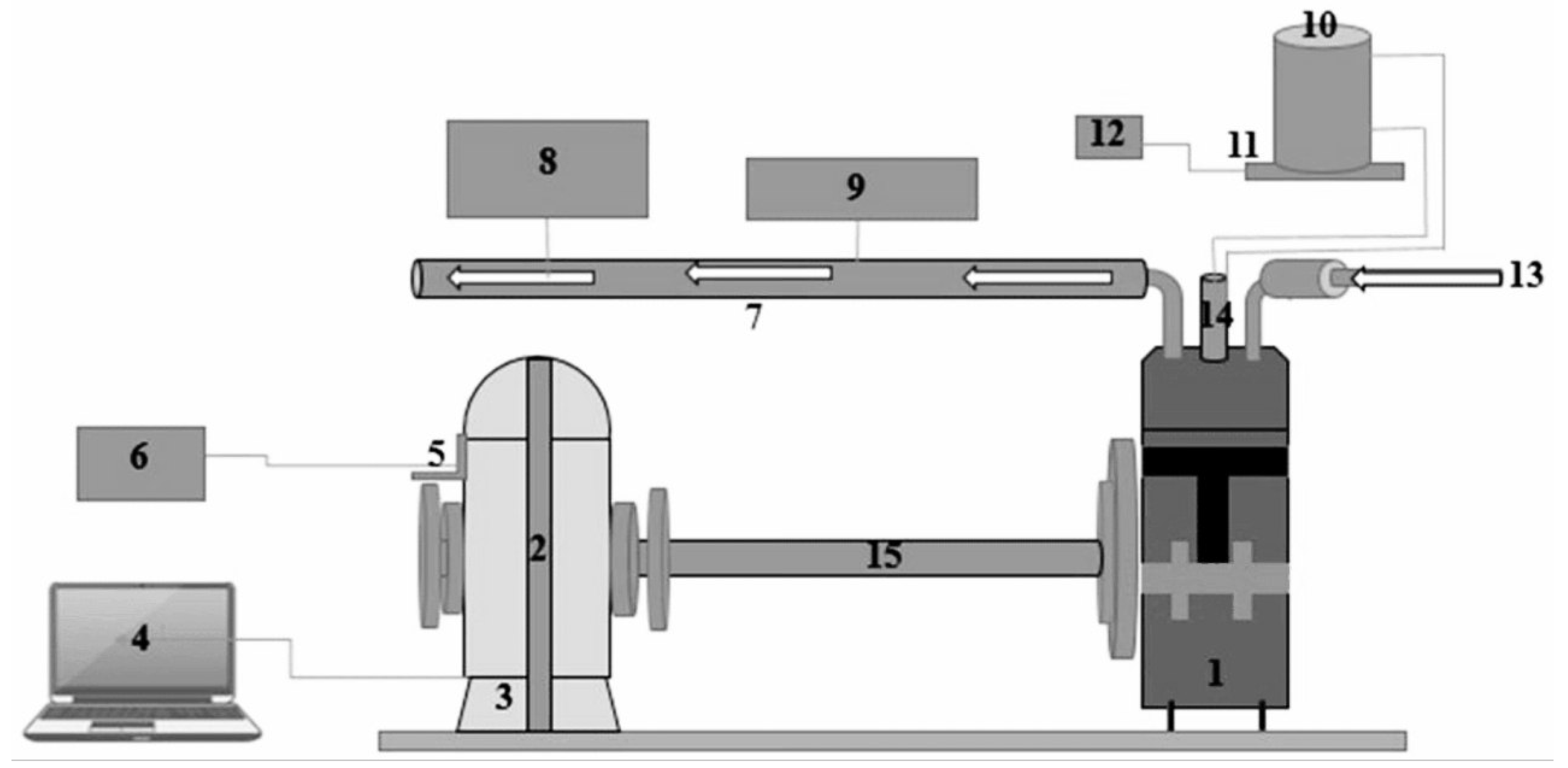
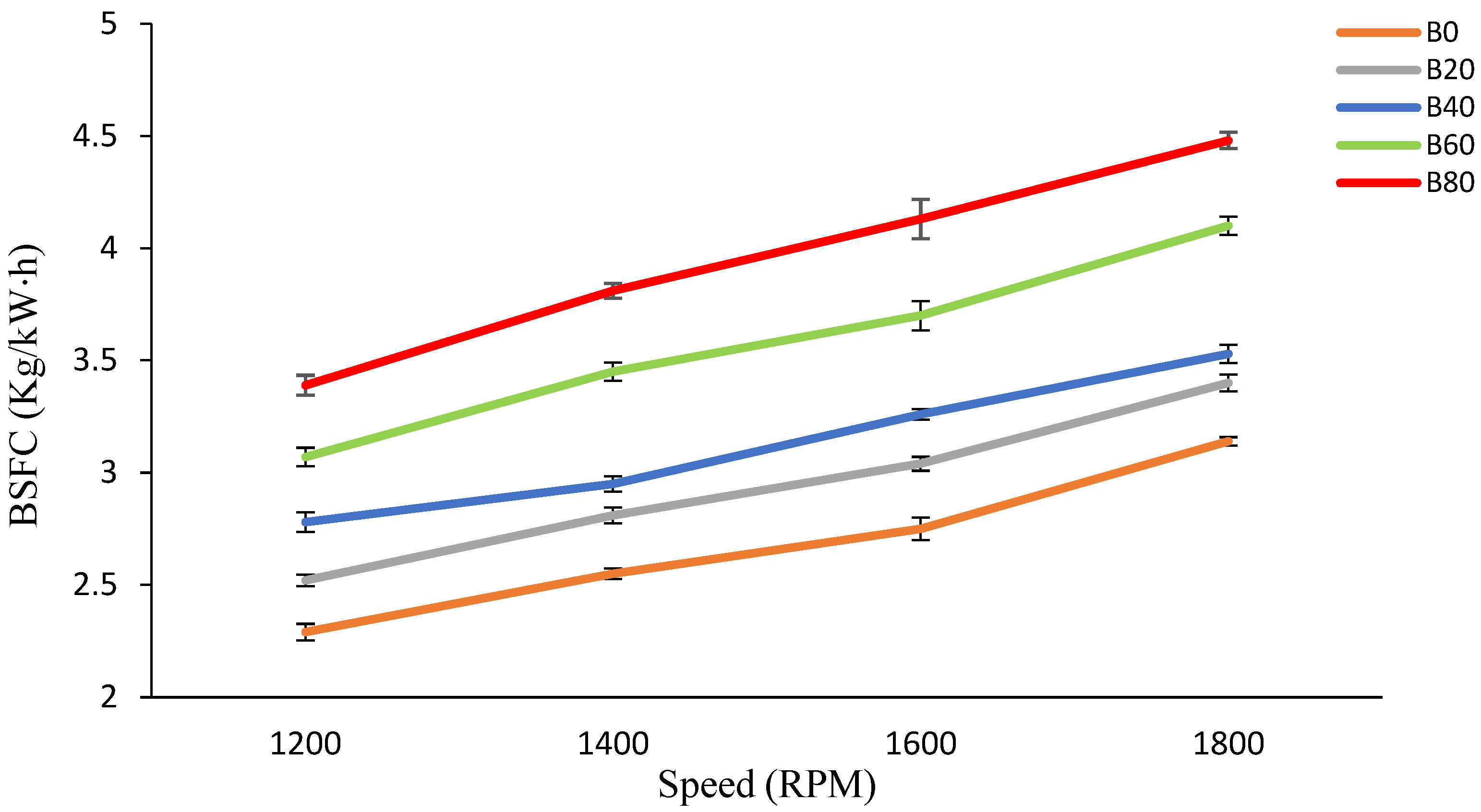
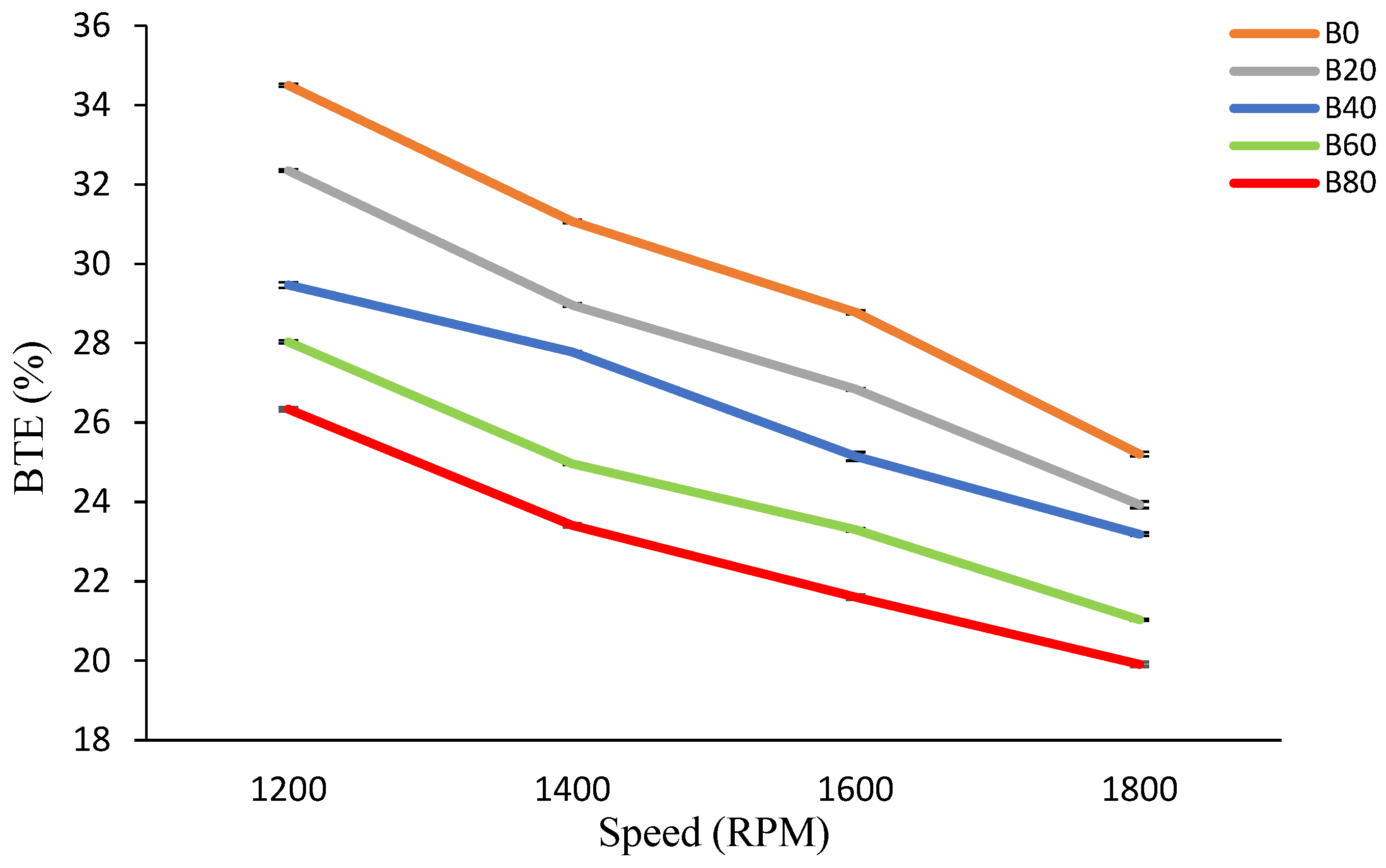

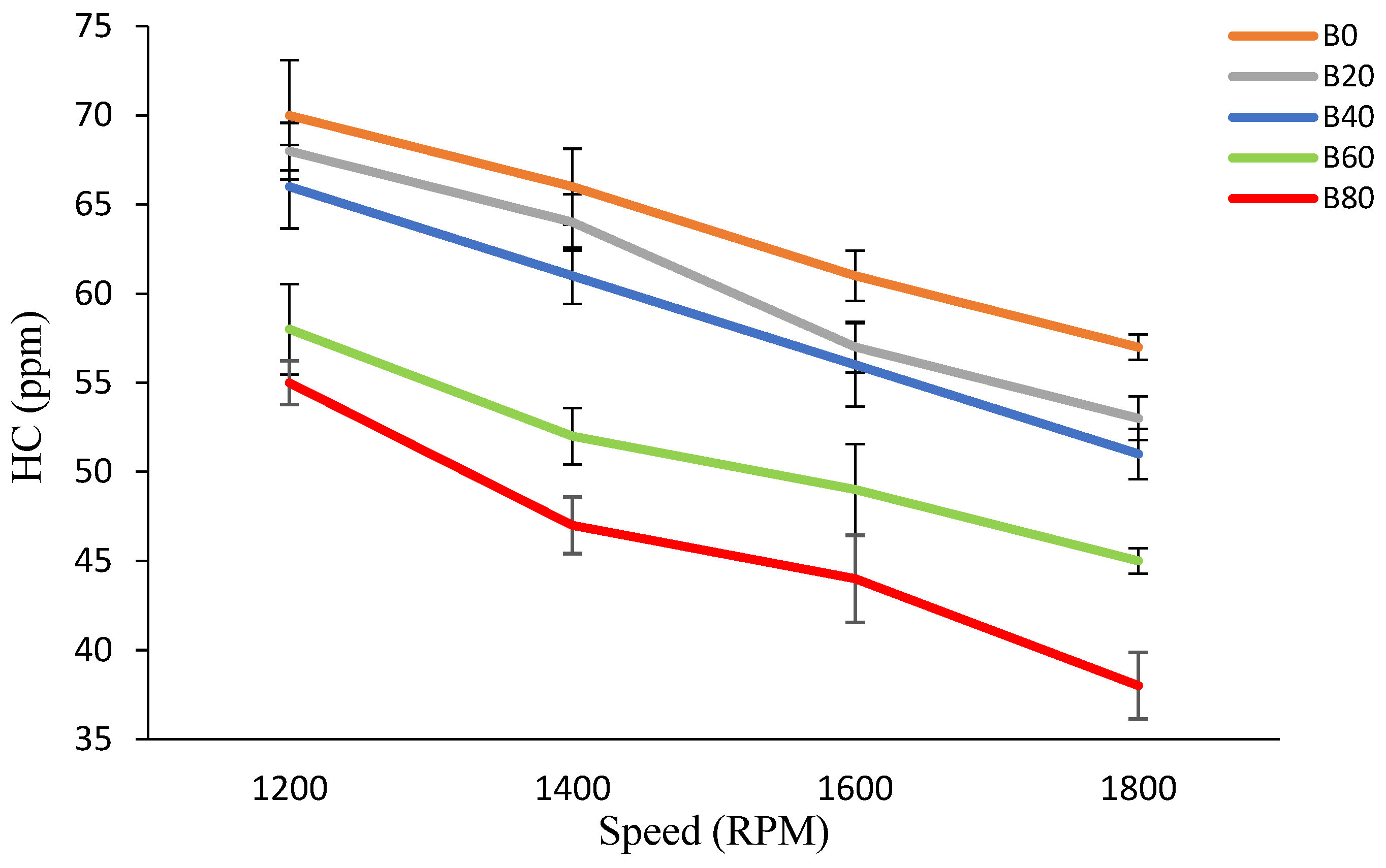

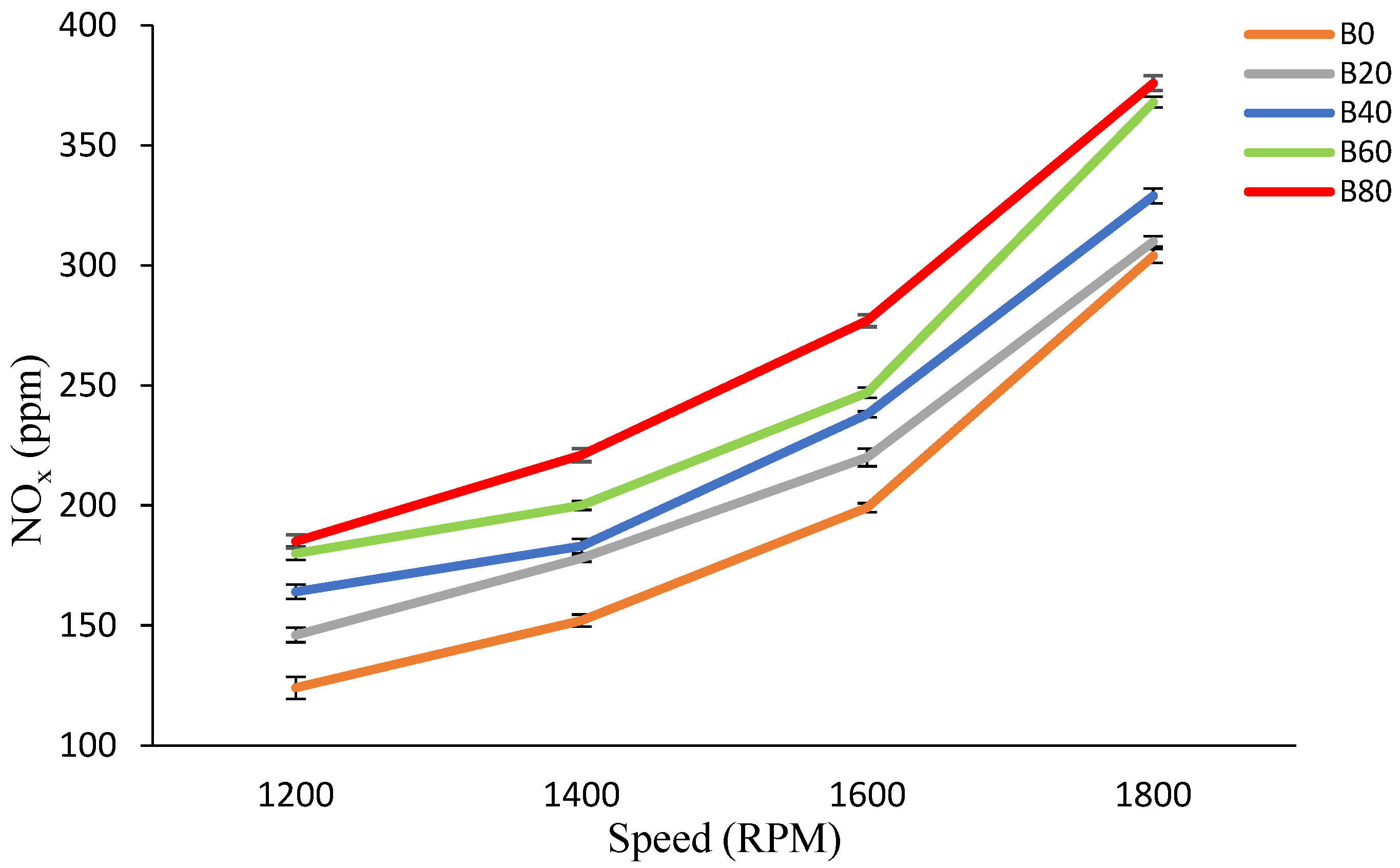
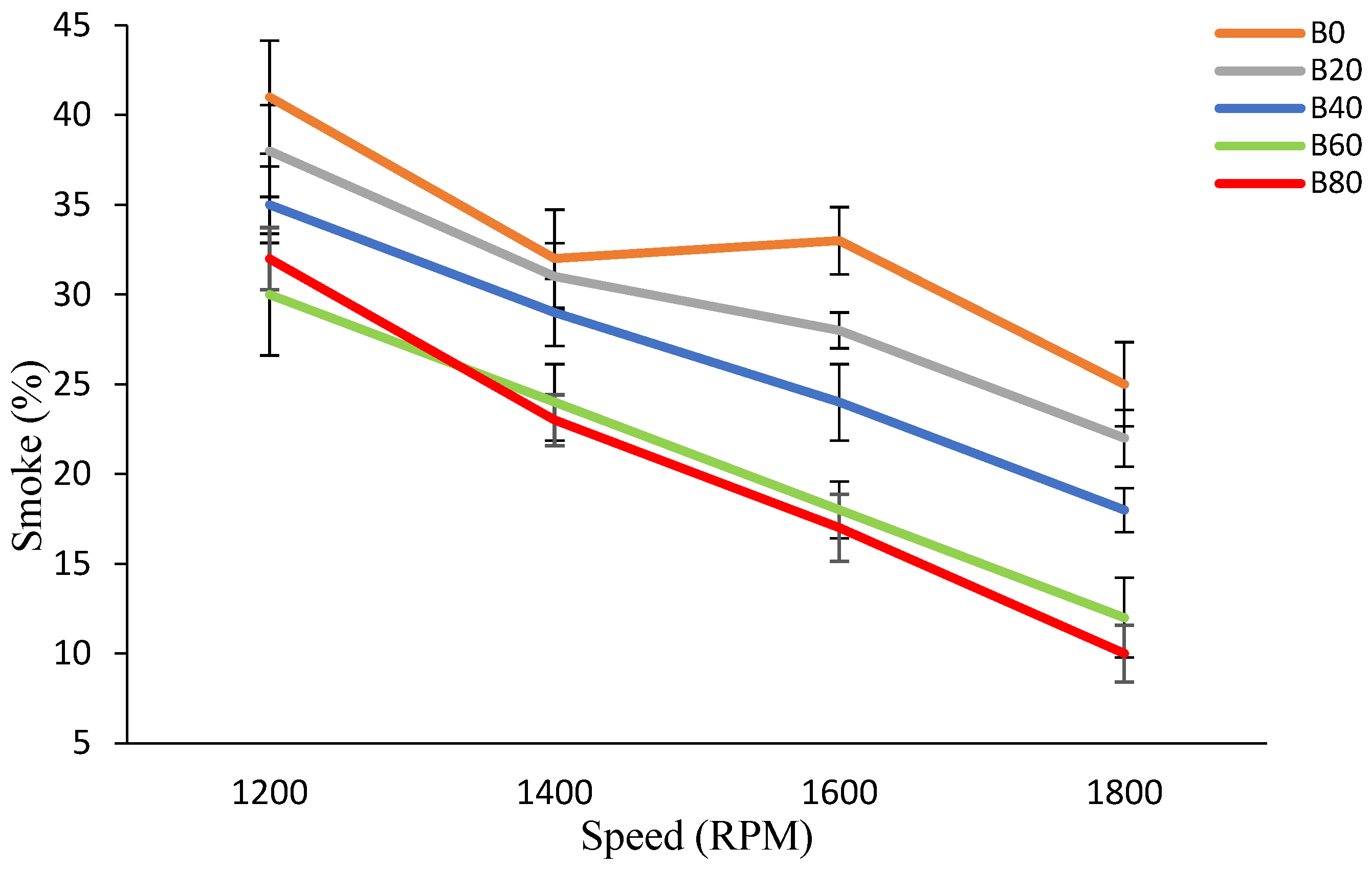
| Manufacturer | Daedong |
|---|---|
| Engine Type | Horizontal, 4-stroke |
| Rated Power Output (kW) | 7.4 |
| Engine Cooling | Water-cooled |
| Number of Cylinders | 1 |
| Stroke Length (mm) | 95 |
| Bore (mm) | 95 |
| Compression Ratio | 21 |
| Displacement (cc) | 673 |
| Injection Pressure (kg/cm−2) | 200 |
| Exhaust Emission | Range | Resolution | Accuracy and Uncertainty |
|---|---|---|---|
| CO | 0.00–10.00 | % | ±0.01% |
| HC | 0–10,000 | ppm | ±1 ppm |
| CO2 | 0.0–20.0 | % | ±0.1% |
| O2 | 0.00–25.00 | % | ±0.1% |
| NOx | 0–5000 | ppm | ±1 ppm |
| Smoke | 0–100 | % | ±0.05% |
| Thermocouple (K-Type) | 0–1200 | ℃ | ±0.1 °C |
| Property | ASTM Standard | Diesel | Lard Biofuel | B20 | B40 | B60 | B80 |
|---|---|---|---|---|---|---|---|
| Density (kg/m3) | 800–880 | 820 | 893 | 827 | 835 | 843 | 864 |
| Viscosity at 40 °C (cSt) | 1.9–6 | 2.87 | 5.91 | 3.31 | 3.82 | 4.55 | 5.26 |
| Flash Point (°C) | >130 | 58 | 114 | 85 | 89 | 95 | 103 |
| Cetane Number | 48–65 | 48.7 | 65 | 52 | 56 | 59 | 63 |
| Calorific Value (Mj/kg) | >35 | 45.51 | 40.21 | 44.18 | 43.95 | 41.76 | 40.35 |
Disclaimer/Publisher’s Note: The statements, opinions and data contained in all publications are solely those of the individual author(s) and contributor(s) and not of MDPI and/or the editor(s). MDPI and/or the editor(s) disclaim responsibility for any injury to people or property resulting from any ideas, methods, instructions or products referred to in the content. |
© 2023 by the authors. Licensee MDPI, Basel, Switzerland. This article is an open access article distributed under the terms and conditions of the Creative Commons Attribution (CC BY) license (https://creativecommons.org/licenses/by/4.0/).
Share and Cite
Khujamberdiev, R.; Cho, H.M.; Mahmud, M.I. Experimental Investigation of Single-Cylinder Engine Performance Using Biodiesel Made from Waste Swine Oil. Energies 2023, 16, 7891. https://doi.org/10.3390/en16237891
Khujamberdiev R, Cho HM, Mahmud MI. Experimental Investigation of Single-Cylinder Engine Performance Using Biodiesel Made from Waste Swine Oil. Energies. 2023; 16(23):7891. https://doi.org/10.3390/en16237891
Chicago/Turabian StyleKhujamberdiev, Ramozon, Haeng Muk Cho, and Md. Iqbal Mahmud. 2023. "Experimental Investigation of Single-Cylinder Engine Performance Using Biodiesel Made from Waste Swine Oil" Energies 16, no. 23: 7891. https://doi.org/10.3390/en16237891






